5th
June
2009
I know, the plans say to build this before building the wings, but I didn’ have room for two jigs and a cart. No problem to build this after the fact, using a paper tracing of a leading-edge rib (the need to have the rib shape is the only reason I can see that this would need to be done before wing construction). I took the left wing out of its jig, then modified the jig to make the cart; shortening the length to 9′, the width to 3′, and removing the uprights. The upright beams are replaced with plywood panels (recycled from the fuselage crate lid)–one end has a cutout to recieve the leading edge, the other end has a cutout to hold the spar root. Need to pick up some wheels to bolt on the bottom, but other than that, it’s ready to go.
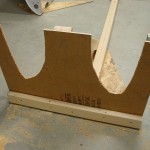

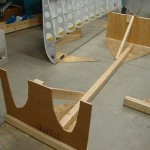
Hours: 2.9 | Posted in Wings |
5th
June
2009
Before dropping the left wing out of the stand (which means turning it nose-down in the wing cart), it seemed like a good idea to fit the lens for the leading-edge light, since it’d be difficult to access in the nose-down position. Followed the directions that came with the kit, and everything worked out nicely. You enlarge the holes in the plexi twice after initial drilling, so there is the opportunity to shift them slightly if alignment needs to be fixed. This one’s not perfect (the holes on the top side ended up being ovaled to tweak the fit), but certainly fine, and the ovals aren’t visible from the outside…once more chance on the other wing.
Trimmed the lens to size with utility knife and bench sander, smoothed with #600 sandpaper, then fit into place using a packing-tape “strap” as described in the instructions. Drilled, drilled some more, deburred and countersunk, then put together the reinforcing strips that hold the nutplates (prepped these for the right wing install too). The lens won’t get fit for good until after the next priming session, so that those strips can be primed, but I did install the internal mounting bracket, now that the LE riveting and AOA installs are complete. Left the bulb out to save it from potential vibration. I think it ended up looking pretty good. At some point after it’s flying, I may pursue the “Pete Howell DIY HID modification” to get more light output…but for now, these ought to get the job done. My plan is to have these on a wig-wag circuit for recognition, as well as taxi/landing steady-on states.
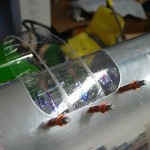
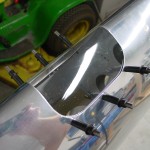
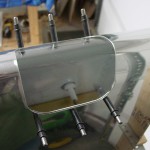
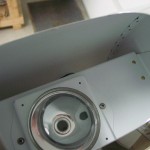
Hours: 2.1 | Posted in Accessories & Mods |
5th
June
2009
One last session with Allison to finish up the skin-spar rivets on the left wing top skins. With that, this wing is ready to come out of the stand! Of course, I forgot to take the “finished” picture in the stand…but here it is after removal from the stand (stand parts being used to build the roll-around wing cart). Couldn’t resist clamping the wingtip on there for a minute to see how it looked.
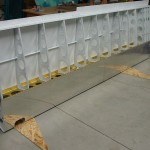
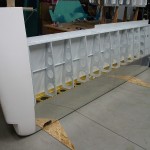
Hours: 0.9 | Posted in Skin Panels |
4th
June
2009
Later in the evening, Allison helped rivet the J-channels into the wing assembly, and re-install a handful of bad rivets that were drilled out from the last session. All that remains to be riveted on the top skins are the skin-front spar rivets.
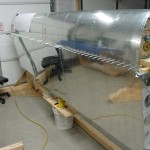
Hours: 0.8 | Posted in Skin Panels |
4th
June
2009
While waiting for the water level to drop in the fuel tank test, assembled and drilled the four aileron brackets, as well as fabricated the aileron stops out of the supplied angle. Set the brackets aside for drilling to the wing after we flip it nose-down in the wing cart. Pondered over the flap brackets, for which there are several parts to fabricate from angle stock, along with much drilling to the wing. Also pulled out the rest of the aileron pieces and removed the blue plastic.
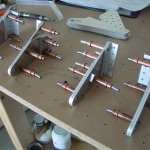
Hours: 1.4 | Posted in Ailerons |
4th
June
2009
Set up the right tank for a leak test…as with the left tank, still fighting with the tape over the fuel cap, but after a couple tries, I think I got it to seal tight. The pressure held fairly consistently until the temperature started to fall as the sun went down, and there were no bubbles observed on the spray-with-soapy-water check (except for the plug in the drain fitting, which I tightened to stop the leak), so I’m optimistic about this one. Having no obvious leaks makes me feel almost as if something’s gone wrong, since reports of leaks on initial testing seem to be common…I suppose the true test will be in several years, when they see fuel for the first time. Left the tank set up on the manometer, and will check again tomorrow to see how it fared.
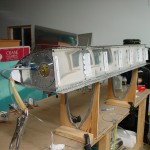
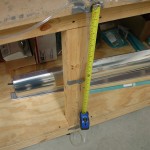
Hours: 1.3 | Posted in Fuel Tanks |
2nd
June
2009
Completed lots of little tasks on the wings today…
- Deburred the top skins and J-channels for the right wing; they’re ready to be dimpled, then etched & primed.
- Finished up the skin-rib rivets on the left wing top skins with Allison.
- Clecoed the left wing J-channels in place; ready to be riveted (along with the skin-spar rivets).
- Riveted the skin-rear spar rivets on the left wing. Easy enough with the squeezer and 4-inch yoke, but the 5 inboard-most rivets are a bear, due to the thickness of the reinforcing bar and doubler plates that comprise the root of the spar. Some creative combinations of squeezing and bucking were required here (eg. half-squeeze to hold the rivet in place, then wiggle the bucking bar in place and finish with the gun, since the squeezer is off center due to the spar bars).
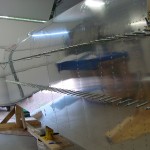
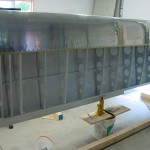
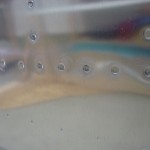
With any luck, the left wing structure ought to be fully riveted by the weekend, and the right wing should be ready to go. I’ll need to look at the plans for the wing cart, as well, and see what I need to pick up for parts. The time is drawing near for the wings to come out of the stands! (Stands were built January 2, 2009.) I also have a plan for adding a second level of shelving to the rollaround workbench to increase its part-storage capacity, which (along with the removal of the wing jigs) will get the fuse parts organized, recovering one space in the garage for summer storm season, and allowing access to the bathroom remodel parts currently stored behind the fuselage kit…
Hours: 5.8 | Posted in Skin Panels |
2nd
June
2009
Hopefully the last session with Proseal, at least on the tanks… Encapsulated the rivet heads on all the skin-baffle rivets, checked over all the external seams and touched up anything that didn’t look 100%, then sealed on the access plate. Swiped some screws out of the fuselage kit hardware for now…will order replacements on the next order from Van’s or elsewhere — $1.50 worth of screws and $10 (or whatever) of shipping didn’t seem like the best use of funds. This tank should be ready for leak testing this weekend.
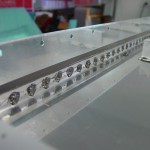
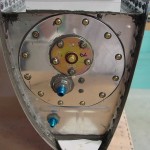
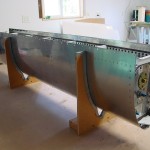
Hours: 2.1 | Posted in Fuel Tanks |
31st
May
2009
Opened the second can of Proseal, and installed the right tank rear baffle. Same process as the first, using the ziploc bag of sealant. Butter the rear of the ribs, drop blobs in the four corners, lines along the rivet holes, butter up the baffle seams, and drop it in place. Cleco every other hole, rivet on the Z-brackets, squeeze the skin-baffle rivets. Fillet the rear seam, encapsulate the baffle-rib rivets, and peel off the tape. Encapsulation of the skin-baffle rivet heads will have to wait for another day, as the Proseal was getting rather stiff by the end of the session. I mixed about 205 grams of sealant, which was enough to do everything here with some left over. (Of course, a good portion of that squeezed out and was wiped off…)
All in all, not bad progress. The confidence boost gained by the successful leak test on the left tank helped, as well. I need to pick up some replacement screws for the access cover before the next sealing session (which, with some luck, should be the last!) As before, I left the tank sitting with the baffle down, in hopes that the sealant will flow into the seam and prevent any leaks. Finally, cleaned all the Proseal off the various tools…still have a bucket of clecos to un-glob, once the stuff sets up.
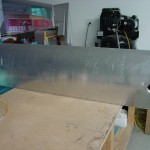
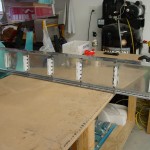
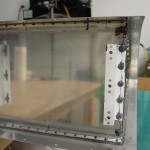
Hours: 5.6 | Posted in Fuel Tanks |
31st
May
2009
Finished the remaining rivets on the inboard skin ribs with Allison.
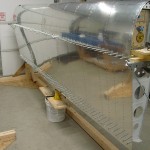
Hours: 0.4 | Posted in Skin Panels |























